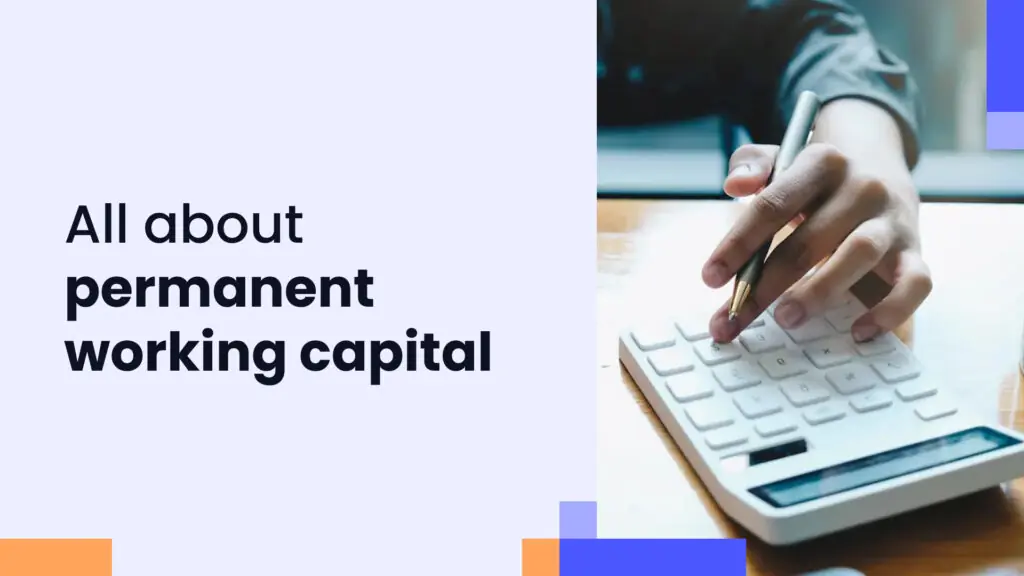- What is permanent working capital?
- Types of permanent working capital
- Other types of working capital
- How do you calculate working capital?
- What are the dangers of ignoring your working capital?
- What is considered sufficient working capital?
- Do you need software to track your permanent working capital?
- Do you need funding to increase your working capital?
- Working capital to grow your eCommerce business
Do you own an eCommerce business? Are you struggling to manage your budget? If so, you may be failing to take an important detail into account. Permanent working capital is a vital element to consider when calculating your budget and is not to be mistaken for net working capital. It’s a consistent and uninterrupted amount of capital you need to keep up with costs so your business can run smoothly.
We’ll discuss what that number means for you, the difference between permanent and temporary working capital, types of working capital, and funding options that will help you keep up with that fixed amount. With that said, let’s dive into the world of working capital, so you can return to your budget with confidence.
What is permanent working capital?
Permanent working capital, also known as fixed working capital, is the fixed amount of money that is needed to cover a business’s most essential expenses. It generally remains consistent, but it can change if your business grows and your regular expenses increase. It can also fluctuate depending on the nature of your operations. If your business grows, for example, you’re going to have more fixed expenses to cover.
Maintaining the right amount of permanent working capital is vital to the survival of your eCommerce business. Without it, you won’t be able to keep up with your business’s bare minimum expenses. Therefore, this value is one of the first things you should determine when calculating your budget. Every other expense can be calculated once the permanent working capital amount is decided.
It’s a good idea to review your expenses first, though, and see whether you can eliminate or reduce them. A lower value of permanent working capital means more cash flow for you.
Examples of permanent working capital expenses include rent, utilities, payroll, and loan payments. If you’re a business that provides services, your accounts receivable can be included in your fixed working capital, especially if they’re on a contractual basis. Customers or clients who operate on a one-time visit or unpredictable schedule shouldn’t be considered a part of your permanent working capital calculations.
Other variables that are particularly relevant for eCommerce businesses are advertising campaigns and inventory, which fluctuate over time. You should also include your own income in your calculation.
Types of permanent working capital
Lack of sufficient capital is one of the top reasons that small businesses fail. Some don’t budget properly while others borrow loan after loan instead of reducing unnecessary costs to maintain their permanent working capital. Business is always a gamble, but it doesn’t mean that you can’t be clever about your strategies.
Subscribe to the eCommerce newsletter for
top industry insights
First and foremost, make sure you can pay your bills. If you can’t do this, you won’t survive. If you pool all your funds into a campaign in the hope that it will deliver massive profits, you’re taking a massive risk.
A good understanding of the two types of working capital can help you budget and ensure that you have the cash flow you need to keep your business going.
1. Regular working capital
Regular working capital is the minimum amount of working capital needed for your business to survive. Your necessary day-to-day expenses such as rent, inventory, loan payments, payroll, and utilities should be included in this value.
It’s a good idea to consider all of your expenses that could be permanent. That means subscriptions to software, regular supplies, and even work-related streaming services. Little things can add up quickly, and if you don’t include them, they can throw off your carefully-calculated budget. So, don’t underestimate your expenses. Always round up your costs if you don’t feel comfortable calculating an exact amount.
2. Reserve working capital
No matter how well you plan out your business operations, surprises are bound to happen. Your rent could increase, a batch of inventory could arrive damaged, a large outstanding balance could be abandoned, or sales could fall unexpectedly. Reserve working capital is your emergency fund for such occurrences.
If you take the time to ensure you have backup funds, your cash flow is less likely to be disrupted – which is great for business. You can always replenish during the next sales spike or even with that new client contract. In short, it’s better to be safe than sorry, so maintaining reserve working capital is a good business practice.
Other types of working capital
It can be difficult to understand the difference between the different types of working capital. There are many variables to each type, meaning there is lots of room for human error. Each business conducts their operations differently, so your expenses may not fit into the same category as the next business, even if it’s the same type of expense.
It’s up to you to figure out which cost goes into which category so you can plan a successful budget for your unique business. We’ve created a list of the types of working capital so you can make an informed decision of your own:
1. Gross working capital
Gross working capital, in short, is the amount of capital invested in current assets. This includes everything that gives value to your business. Tangible assets include invoices, property, inventory, stocks, backup funds, office furniture, and company vehicles. All these variables and more can be included in your gross working capital.
When applying for financing, banks and lenders use this value to determine eligibility and the amount of money they’re willing to provide you. Therefore, it’s always a good idea to keep records of every cost related to your business, no matter how small you think it is. It may make a big difference down the line with banks or private investors.
2. Net working capital
This is the working capital that most people think of when they come across the term. It’s the value of your working capital after you subtract your liabilities from your current assets. This figure determines how well your business is doing, or the health of your company. The goal is to have a positive number after subtracting your current liabilities from your current assets.
Your net working capital is meant to fund non-essential aspects of the business, such as extra inventory, advertising, and office furniture. These short-term expenses need to be paid if you want to succeed, but their prioritization comes in second compared to permanent working capital.
3. Temporary working capital
This is the type of working capital that fluctuates the most. Temporary working capital is net working capital minus permanent working capital. It’s the money you need for shorter term expenses such as planning product launches and boosting advertising campaigns. It’s also for preparing for the inevitable slow season, especially if you are a seasonal business.
Temporary working capital is just as important to calculate as the other types of working capital. It differs, however, because it changes with the seasons and trends throughout the year.
| Type of working capital | Description | Typical expenses | Duration |
|---|---|---|---|
| Permanent working capital | Fixed amount for essential expenses | Rent, utilities, payroll, loans | Consistent |
| Regular working capital | Minimum required for day-to-day operations | Rent, inventory, loans, payroll | Ongoing |
| Reserve working capital | Emergency funds for unexpected costs | Varies (e.g., damaged inventory) | As needed |
| Gross working capital | Total capital invested in current assets | Invoices, property, inventory | Varies |
| Net working capital | Current assets minus liabilities | Extra inventory, advertising | Varies |
| Temporary working capital | Fluctuating capital for short-term needs | Product launches, seasonal prep | Short-term |
How do you calculate working capital?
If you were looking for a formula to work with, then we have bad news—there isn’t one. Every business is different and has various variables that can’t fit into one equation. You’ll need to take a look at the inner financial details of your business to arrive at a conclusion. However, we will provide you with helpful methods to guide you through the process.
Remember, every expense counts, so gather all your documents and set aside a few hours to calculate everything. Let’s walk through the process of determining your permanent working capital.
1. Assess net working capital
First, you need your net working capital figure. As referenced above, it can be calculated by subtracting your liabilities from your current assets. Once you know this value, you can calculate how healthy your business is. If your net working capital is positive, you’re in good shape. From there, you can grow it.
2. Break it down
To get a better understanding of your costs, you need to break down your net working capital and how it’s used day to day. The small picture is just as important as the big picture. You may see things that you can change or can improve in order to lower your costs. You’ll also gain a better understanding of what aspects of your business are taking up the largest portion of your budget.
Popular content
- 14 strategies to improve your eCommerce business’s financial health
- 50+ ChatGPT prompts to elevate your eCommerce business
- A guide to pricing your product on Amazon
- 5 marketing metrics all eCommerce businesses should track
- All about Amazon PPC
3. Add up fixed costs
Add up all your fixed costs. These are the things that go into your permanent working capital, the necessary expenses that need to be paid in order for your business to keep its doors open. Seeing this figure will allow you to eliminate unnecessary expenses and even reduce some that you didn’t see before. Can you refinance your business loan? Maybe you can lower the monthly payments. Things like this make a big difference in the long run.
4. Be prepared for the future
As you grow your business, you’ll consequently add more to your permanent working capital. More expenses will pop up as you decide to climb higher up the ladder. Make sure you have sufficient backup funds to compensate for these projected expenses. You don’t want to rely entirely on loans and credit cards.
Might also interest you:
- Why just-in-time funding is the future for eCommerce
- 7 reasons successful eCommerce sellers opt for funding to fuel growth instead of relying on profits
- The hidden dangers of delayed funding
What are the dangers of ignoring your working capital?
Working capital is a vital piece of your eCommerce business. If you don’t calculate and track it, you won’t have a good idea of the amount needed for each expense and venture. Credit cards and loans have their place when it comes to growing your business, but debt financing can quickly grow out of control if you don’t have a decent system set up to keep track of your working capital, permanent or otherwise.
Spending has to be monitored, especially when there are multiple people involved in the company’s operations. Here are some of the consequences you may face if you don’t stay on top of your working capital.
1. Insufficient inventory
Inventory is vital to your business, and you need plenty of cash flow to keep up with demand. If you don’t keep up with demand, you will lose customers because most people won’t wait for something that’s on backorder. They’ll simply go to the next retailer that is stocked with their item. If you spent quite a bit on advertising for a trending item, then the advertising expense would go to waste, too, if you don’t have the money to order more of the goods. Going out of stock is a costly error for your business, and can have far reaching effects. It affects your ranking, harms customer experience, and results in lost sales.
2. Low liquidity
Emergencies and surprise expenses happen. If you don’t have any reserve working capital, then you may be in trouble. When you don’t have enough cash on hand to pay your employees, they may get a bit irritated. If you maintain office space or a physical storefront, you need the funds to pay rent and utilities, too.
For eCommerce businesses, it’s important to have extra cash on hand to deal with unexpected supply chain delays and disruptions. A shipment can get held up in port or a batch of inventory can arrive damaged. Sudden changes in demand can also lead to cash flow problems if you’re not prepared. Maintaining the necessary levels of working capital can save your business in these cases.
3. Penalties
Penalties start popping up when you are unable to catch up and pay your expenses. Most banks and lenders aren’t forgiving when it comes to missed payments. Penalties can stack up and interest can be increased, which only worsens the situation.
Keeping working capital on hand will guarantee a smooth transition through the surprise costs that come with the emergency. The best way to prepare is to review your budget often, and make sure that you are staying on track.
4. Bankruptcy
Bankruptcy is the worst case scenario. This happens when you are unable to pay your debts, so you have to sell your assets to pay them off. No one wants to lose their business due to bad math skills or a risky business strategy.
Never assume that you’ll grow right away, or even receive profits right away. Permanent working capital is a necessary figure to calculate in order to avoid this situation. It’s always better to break even than to fall into the negatives.
What is considered sufficient working capital?
The answer to this question is individual and depends on your unique business needs and goals. You can start by mapping out your current and future goals for the business, whether that’s improving customer service or expanding to another location. With these answers, you’ll be able to budget according to the expenses you’ll have from these ventures. How many products do you sell? How much inventory do you keep in stock? Is your business seasonal? What platforms do you use for your online store? Are you looking to grow or scale your business?
After you answer these questions and come up with your permanent working capital figure, you’ll be able to determine on your own what your optimal value is. If you are trying to get by on the bare minimum, any positive figure would be a great goal. If you want to scale and begin selling another product, your goal is to grow the net working capital, so you can purchase inventory and pay for warehouse storage space. Only you know for sure how much working capital you need to achieve your goals.
Do you need software to track your permanent working capital?
Technically, you don’t need budgeting software to calculate your budget, which includes your permanent working capital. However, calculating working capital by hand increases the risk of human error.
Pen and paper are great for quick calculations, but with all the different variables that come with budgeting, we recommend you invest in decent budgeting software. This is especially true if you are planning on expanding or simply working with large numbers. When you reach thousands of customers online, then you probably have lots of inventory to keep up on, too. Software can help with every aspect of your business, as working capital touches all of it.
If, on the other hand, you run a small online store with little inventory and little permanent working capital, then you may not need software. There are also a couple downsides that come with trusting robots to do our dirty work. Hackers are constantly searching for ways to get their hands on information, including your business details and customer profiles. This can be avoided with antivirus software, though. Computers can also be corrupted, have power failures, or overload, which means you may lose your data. When in doubt, backup your information.
Do you need funding to increase your working capital?
Business funding can be vital to keep up with expenses while maintaining your working capital. You need to make sure that you have enough money to keep that permanent working capital permanent, and that means not dipping into your cash flow.
There are various financing options for start-ups and fast-growing eCommerce businesses. It’s all about finding the right conditions and type of funding that fits your needs. Each financing company has their own guidelines, regulations, and conditions, so it’s important to do your research and determine which one will work best for your business. Let’s take a look at some common funding options for eCommerce sellers so you can manage your budget with confidence.
1. Working capital loan
Working capital loans provide you with consistent cash that you pay off in the short-term. If you struggle to keep up with day-to-day expenses, such as rent, payroll, utilities, and inventory, then this is a good route to take. Plus, there’s often no restrictions on how you spend your money. If you want to spend it on inventory for that upcoming sales spike, then go for it.
Keep in mind that these types of loans come with higher interest rates, which can make it difficult to keep up with monthly payments. So, plan accordingly when applying for this loan.
2. Secured or unsecured business loan
A business loan is a lump sum of money loaned to you by a bank or lender. You can obtain a secured loan more easily than an unsecured one, but you’ll have to put up your own assets as collateral. Secured loans usually have lower interest rates, too, but you risk losing your assets in the case you fail to pay back your loan. This may be the route to take if you have the assets to offer, and feel confident in your ability to pay the monthly costs.
Unsecured loans won’t require any collateral, but they will control what you spend your money on. If you tell them it’s for daily operations, then you will have to spend it on those costs, unless otherwise approved. Plus, unsecured loans tend to have higher interest rates.
3. Business line of credit
If you’re looking for revolving credit, so you always have money for daily expenses, then a business line of credit could be the right choice for you. The money becomes available to you again as you pay off the loan, and you’re only charged interest on the portion of the loan you’re using.
Business lines of credit typically have lower interest rates, and they’re easier to access than most funding. The down side can be the amount you can obtain from your lender. Most of the time, these loans are on the lower side, but if it fits your budget, then go for it. If you’re looking to expand, then something like a business loan might be a better fit.
4. Merchant cash advance
If you have a hard time getting approved at banks, then a merchant cash advance might be a good choice. It’s often easier to get approved for, and your credit score isn’t always a factor in their decision. If approved, you’ll receive a lump sum of capital in exchange for a percentage of each future debit and credit card sale. The great part about this option is that you have complete control of what you spend the money on. So, if you want to increase your advertising budget, you are able to do so.
5. Crowdfunding
If you aren’t having any luck getting approved by banks or lenders, you can turn to crowdfunding. This is when a community of individuals invest in your business idea, often through a crowdfunding platform.
While crowdfunding campaigns can be challenging to get off the ground, they can help you build momentum, especially if you’re just starting your eCommerce business. You often don’t have to pay your investors back or give up any equity, instead offering gifts or rewards to your backers. This can be a great way to fund your business, but remember that less than a quarter of crowdfunding ventures are successfully funded.
| Funding option | Description | Pros | Cons |
|---|---|---|---|
| Working capital loan | Short-term loan for daily expenses | Flexible use, quick access | Higher interest rates |
| Secured business loan | Lump sum loan with collateral | Lower interest rates, easier to obtain | Risk of losing collateral |
| Unsecured business loan | Lump sum loan without collateral | No risk to assets, flexible use | Higher interest rates, restricted usage |
| Business line of credit | Revolving credit for daily expenses | Interest on used portion, accessible | Lower loan amounts |
| Merchant cash advance | Lump sum for a percentage of future sales | Easy approval, flexible use | Higher cost, dependent on sales |
| Crowdfunding | Community-funded without repayment | No debt or equity loss, potential momentum | Challenging to succeed, time-consuming |
Working capital to grow your eCommerce business
There’s no question that businesses require plenty of working capital to grow. Plus, eCommerce sellers are all too familiar with the cash flow crunch that often results from their compounding supply chain expenses. Since these costs must be paid before sellers see any revenue from sales, having extra cash on hand is a must.
If you need a working capital boost for your eCommerce business, 8fig can help. Our cash flow friendly funding is aligned to your supply chain expenses, making it easy to ensure that you always have enough working capital. Plus, our funding is continuous and flexible. You get funding injected into your business continuously, as you need it, and you have the freedom to adjust your Growth Plan in real time.
Interested in learning more? Sign up for an 8fig Growth Plan today, and find out how we can help you reach your goals.
Have article ideas, requests, or collaboration proposals? Reach out to us at editor@8fig.co – we’d love to hear from you.
- The hidden cost of stockouts: A data-driven analysis showing how missing inventory impacts your eCommerce revenue
- 100 questions for eCommerce sellers to ask ChatGPT
- Holiday rush readiness: top 8 tips for handling seasonal demand peaks
- Seasonal or regular: Discover your seller type
- 14 strategies to improve your eCommerce business’s financial health
Subscribe to the eCommerce newsletter for
top industry insights
to our blog
Read the latest
from 8fig

AI is quietly reshaping eCommerce. Karma’s Hadas Bar-Ad explores how today’s sellers are using intelligent tools to streamline operations, boost efficiency, and drive smarter growth.

WhatsApp isn’t just for memes and group chats anymore. With a 98% open rate, it’s the secret weapon your eCommerce marketing strategy might be missing. Here’s how to do it right.

Stuck with extra inventory after Amazon’s Spring Sale? Learn five smart strategies to clear unsold stock, boost cash flow, and avoid future overstocks with smarter inventory planning.
